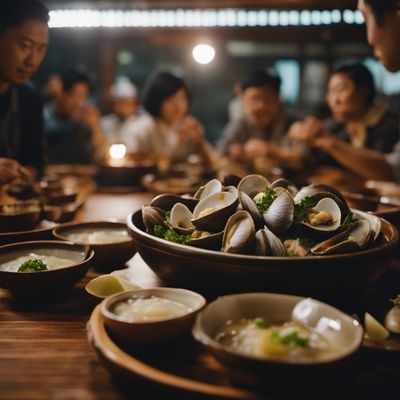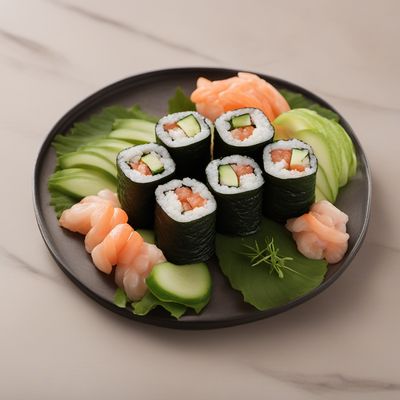
Recipe
Sobagaki with Kinako Sauce
Deliciously Nutty Sobagaki: A Traditional Japanese Delight
4.0 out of 5
Sobagaki is a traditional Japanese dish made from buckwheat flour. It is a simple yet comforting dish that is often enjoyed during the colder months. This recipe takes Sobagaki to the next level by serving it with a delightful kinako sauce, adding a nutty and sweet flavor to the dish.
Metadata
Preparation time
15 minutes
Cooking time
5 minutes
Total time
20 minutes
Yields
4 servings
Preparation difficulty
Easy
Suitable for
Vegetarian, Vegan, Gluten-free, Dairy-free, Nut-free
Allergens
Soy
Not suitable for
Paleo, Keto, Low-carb, High-protein, Atkins
Ingredients
-
1 cup (120g) buckwheat flour 1 cup (120g) buckwheat flour
-
1/2 cup (120ml) hot water 1/2 cup (120ml) hot water
-
1/4 cup (30g) kinako (roasted soybean flour) 1/4 cup (30g) kinako (roasted soybean flour)
-
2 tablespoons sugar 2 tablespoons sugar
-
1/4 cup (60ml) water 1/4 cup (60ml) water
Nutrition
- Calories (kcal / KJ): 180 kcal / 753 KJ
- Fat (total, saturated): 1g, 0g
- Carbohydrates (total, sugars): 39g, 8g
- Protein: 6g
- Fiber: 4g
- Salt: 0.01g
Preparation
-
1.In a mixing bowl, combine the buckwheat flour and hot water. Mix well until a dough-like consistency is formed.
-
2.Divide the dough into small portions and shape them into balls or dumplings.
-
3.Bring a pot of water to a boil and carefully drop the Sobagaki into the boiling water.
-
4.Cook the Sobagaki until they float to the surface, which usually takes about 2-3 minutes.
-
5.While the Sobagaki are cooking, prepare the kinako sauce by combining the kinako, sugar, and water in a small saucepan.
-
6.Cook the kinako sauce over low heat, stirring constantly until it thickens and becomes smooth.
-
7.Once the Sobagaki are cooked, remove them from the boiling water using a slotted spoon and transfer them to a serving plate.
-
8.Drizzle the kinako sauce over the Sobagaki and serve immediately.
Treat your ingredients with care...
- Buckwheat flour — Make sure to use high-quality buckwheat flour for the best results. If you can't find buckwheat flour, you can substitute it with a mixture of all-purpose flour and whole wheat flour.
- Kinako — Look for roasted kinako, as it has a more intense flavor. If you can't find kinako, you can roast soybean flour at home by toasting it in a dry pan until it turns golden brown.
Tips & Tricks
- To add extra flavor to the Sobagaki, you can mix in some finely chopped green onions or grated ginger into the dough before shaping it into balls.
- If you prefer a sweeter kinako sauce, you can increase the amount of sugar according to your taste.
- Serve the Sobagaki with a side of traditional Japanese pickles for a refreshing contrast of flavors.
- Leftover Sobagaki can be stored in an airtight container in the refrigerator for up to 2 days. Reheat them by briefly boiling them in water before serving.
- Experiment with different toppings for the Sobagaki, such as toasted sesame seeds or a drizzle of honey, to add your own personal touch.
Serving advice
Serve the Sobagaki with Kinako Sauce as a warm and comforting appetizer or snack. Arrange the Sobagaki on a plate and drizzle the kinako sauce generously over them. Garnish with a sprinkle of kinako or a dusting of powdered sugar for an extra touch of elegance. Enjoy them while they are still warm for the best taste and texture.
Presentation advice
To present the Sobagaki with Kinako Sauce beautifully, place the cooked Sobagaki on a traditional Japanese ceramic plate or a wooden serving tray. Drizzle the kinako sauce in an artistic pattern over the Sobagaki, allowing it to cascade down the sides. Garnish with a sprig of fresh mint or a dusting of kinako for an eye-catching presentation.
More recipes...
More Japanese cuisine dishes » Browse all

Asari no sakemushi
Steamed Clams with Sake
Asari no sakemushi is a traditional Japanese seafood dish that is made with clams and sake. The dish is typically served as an appetizer and is...

Tempura soba
Tempura Soba
Tempura soba is a Japanese dish that consists of soba noodles served in a hot broth with tempura on top. The dish is a popular comfort food in...

Katsuo no tataki
Seared Bonito
Katsuo no tataki is a Japanese dish made from seared bonito fish. It is a popular dish in Japan, and is often served as an appetizer or snack.




